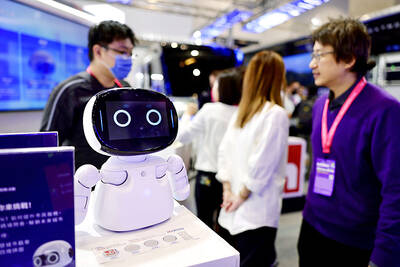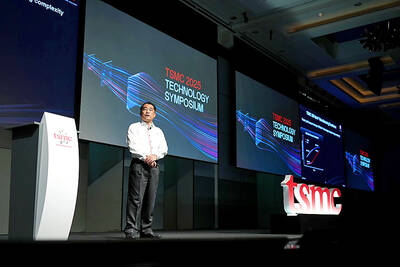Wall Street giant Goldman Sachs shattered forecasts on Tuesday with US$3.44 billion in quarterly profits after paying back a US government bailout, suggesting the financial crisis is easing.
Goldman, which reimbursed a US$10 billion federal bailout in full in the second quarter, said its net profit soared 65 percent thanks to robust trading operations.
The prestigious financial firm is the first of the “big guns” in the sector to report second-quarter results. Rounding out the week is JPMorgan Chase today, followed by Bank of America and Citigroup tomorrow.
Goldman reported earnings per share of US$4.93, besting analysts’ forecast of US$3.54.
“While markets remain fragile and we recognize the challenges the broader economy faces, our second-quarter results reflected the combination of improving financial market conditions and a deep and diverse client franchise,” chairman and chief executive Lloyd Blankfein said in a statement.
Goldman, the last of the major Wall Street investment banks left standing after the financial meltdown late last year, said that excluding its payback of government aid under the US Treasury’s Troubled Asset Relief Program (TARP), it had earnings per share of US$5.71.
Last month Goldman was among 10 major US banks repaying the Treasury for the capital injections, in a sign of a stabilizing financial system.
A number of firms were eager to get out from under the TARP, in part to escape federal scrutiny of executive compensation.
Goldman’s gold-plated earnings came as investors fretted about embattled CIT Group, a major player in industrial loans.
CIT, which operates in more than 50 countries and provides financial services to small and medium-sized businesses, is seeking fresh government aid to avoid collapse.
The Wall Street Journal reported yesterday that CIT was nearing a deal in its talks with federal regulators to obtain a government aid package. The cash-strapped company’s board, it said, had discussed a number as high as US$775 million for the drawdowns.
US government officials are split over the amount of aid that should be given to CIT and, some say, CIT is seeking to exaggerate the consequences of its potential collapse, the newspaper said.
“There is also the risk that propping up CIT will reinforce the stigma that Washington will bail out companies that aren’t even considered too big to fail,” it said.

DEMOGRAPHICS: Robotics is the most promising answer to looming labor woes, the long-term care system and national contingency response, an official said Taiwan is to launch a five-year plan to boost the robotics industry in a bid to address labor shortages stemming from a declining and aging population, the Executive Yuan said yesterday. The government approved the initiative, dubbed the Smart Robotics Industry Promotion Plan, via executive order, senior officials told a post-Cabinet meeting news conference in Taipei. Taiwan’s population decline would strain the economy and the nation’s ability to care for vulnerable and elderly people, said Peter Hong (洪樂文), who heads the National Science and Technology Council’s (NSTC) Department of Engineering and Technologies. Projections show that the proportion of Taiwanese 65 or older would

Nvidia Corp yesterday unveiled its new high-speed interconnect technology, NVLink Fusion, with Taiwanese application-specific IC (ASIC) designers Alchip Technologies Ltd (世芯) and MediaTek Inc (聯發科) among the first to adopt the technology to help build semi-custom artificial intelligence (AI) infrastructure for hyperscalers. Nvidia has opened its technology to outside users, as hyperscalers and cloud service providers are building their own cost-effective AI chips, or accelerators, used in AI servers by leveraging ASIC firms’ designing capabilities to reduce their dependence on Nvidia. Previously, NVLink technology was only available for Nvidia’s own AI platform. “NVLink Fusion opens Nvidia’s AI platform and rich ecosystem for

Taiwan Semiconductor Manufacturing Co (TSMC, 台積電) yesterday said it is building nine new advanced wafer manufacturing and packaging factories this year, accelerating its expansion amid strong demand for high-performance computing (HPC) and artificial intelligence (AI) applications. The chipmaker built on average five factories per year from 2021 to last year and three from 2017 to 2020, TSMC vice president of advanced technology and mask engineering T.S. Chang (張宗生) said at the company’s annual technology symposium in Hsinchu City. “We are quickening our pace even faster in 2025. We plan to build nine new factories, including eight wafer fabrication plants and one advanced

‘WORLD’S LOSS’: Taiwan’s exclusion robs the world of the benefits it could get from one of the foremost practitioners of disease prevention and public health, Minister Chiu said Taiwan should be allowed to join the World Health Assembly (WHA) as an irreplaceable contributor to global health and disease prevention efforts, Minister of Foreign Affairs Lin Chia-lung (林佳龍) said yesterday. He made the comment at a news conference in Taipei, hours before a Taiwanese delegation was to depart for Geneva, Switzerland, seeking to meet with foreign representatives for a bilateral meeting on the sidelines of the WHA, the WHO’s annual decisionmaking meeting, which would be held from Monday next week to May 27. As of yesterday, Taiwan had yet to receive an invitation. Taiwan has much to offer to the international community’s